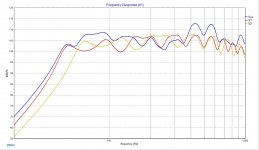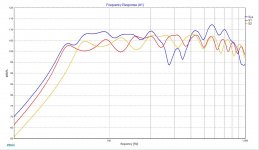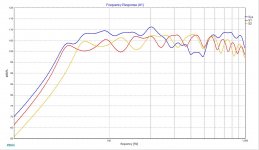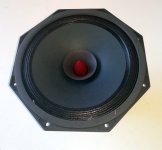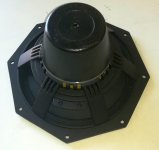Looking for someone who simulated double bass horn with Manger and rear fullrange:
Posaune
vs.
Single bass horn: Manger Basstuba
Going to try this enclosure but maybe in another shape. It uses wood wool.
Posaune
vs.
Single bass horn: Manger Basstuba
Going to try this enclosure but maybe in another shape. It uses wood wool.
The bass horn can be done directly in Hornresp if you have the driver parameters.
The double horn are actually two separate horns of different length, each with its own driver. I think these could be simulated separately in Hornresp, and then add the FRs properly in another program. On this however I have not seen the horn lenghts listed, maybe Horst himself can answer that question. Then, they could be aproximated with exponential horns to have an idea how that may work.
It should be definitely possible in Aakabak and maybe ABEC, but that is way out of my skills.
Edit: I just tried to do a quick test - default horn driver, horn lengths 270 cm and 202,5 (3/4 - not sure if that is the correct ratio). One horn is the red one, the other one yellow, combined is blue, done in XSim.
Edit2: This is combined output of two horns and two drivers. Maybe it is not really the correct way of doing it, but could serve as a first guess.
The double horn are actually two separate horns of different length, each with its own driver. I think these could be simulated separately in Hornresp, and then add the FRs properly in another program. On this however I have not seen the horn lenghts listed, maybe Horst himself can answer that question. Then, they could be aproximated with exponential horns to have an idea how that may work.
It should be definitely possible in Aakabak and maybe ABEC, but that is way out of my skills.
Edit: I just tried to do a quick test - default horn driver, horn lengths 270 cm and 202,5 (3/4 - not sure if that is the correct ratio). One horn is the red one, the other one yellow, combined is blue, done in XSim.
Edit2: This is combined output of two horns and two drivers. Maybe it is not really the correct way of doing it, but could serve as a first guess.
Attachments
Last edited:
Here is the FR with 5 inch and 10 inch spacing between the two drivers/horns.
Again, not sure that all I am doing is correct, but it seems that the double horn should work in principle (I did not doubt about that, this is just a small proof to me).
Again, not sure that all I am doing is correct, but it seems that the double horn should work in principle (I did not doubt about that, this is just a small proof to me).
Attachments
Thanks pelanj - will draw that horn and calculate values for Hornresp. I have ambitious plan - redraw it in a more fancy way and print.
Rear driver will be different as I can get only one pair of MSWs.
Rear driver will be different as I can get only one pair of MSWs.
Attachments
Last edited:
Dual tapped horns with phase correction, Voice Coil, Oct 2019 issue:
One example of Category #2 that was found to be significant was working with tapped horns. If you construct a dual-tapped horn where one of the tapped horns was tuned to 20 Hz and the second tapped horn was tuned to about 26 Hz, causing an excursion minimum in the second tapped horn where the first tapped horn had an excursion maximum. If you run these in parallel, and EQ shape the response of each to take advantage of keeping their X-max overload to a minimum, you can “potentially” significantly increase total system output for the same amount of driver size and enclosure volume. I say “potentially” because their output is compromised by sharp phase changes around the two tuning frequencies, such that the systems partially cancel each other instead of being additive.
However, with phase correction, the two systems can be brought in-phase with each other and exhibit the full large signal amplitude benefits of zero phase differential, and full amplitude summation. So, in this case, the benefit has nothing to do with improving phase errors for the purpose of sound “quality”, but instead using the improved phase correction for improved sound “quantity.”
The system just happens to be phase corrected, as a secondary effect, but that aspect of the improvement will be audibly insignificant. But the large signal improvement is approximately 7 dB. I’ll take that over straining to hear a phase change any day!
I found the same effect when combining a fourth-order single tuned band-pass in parallel with a sixth-order dual
tuned band-pass woofer, and integrating them as a hybrid system. Without phase correction there is actually an amplitude loss, but with phase correction one can achieve 5 dB to 8 dB of increased large signal capability. There are more examples, but these are the ways that this type of phase correction can have “real world” payoffs.
- Status
- Not open for further replies.
- Home
- Loudspeakers
- Multi-Way
- Manger/Fullrange double bass horn Hornresp
